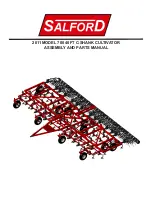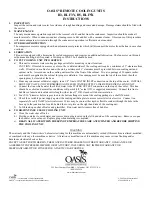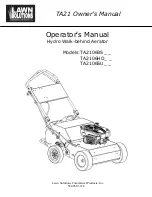
Tilling
Tilling is digging in, turning over and breaking up
garden soil and prepare a seedbed for planting.
Best tilling depth is 100mm (4”) to 150mm (6”). A
tiller will also clear the soil of unwanted vegetation.
The decomposition of this vegetation matter
enriches the soil.
Avoid tilling soil that is too dry as it will pulverize
and produce a dust that will not hold water. Water
a few days before tilling. Also, tilling soil that is
too wet will produce unsatisfactory clods. Wait a
day or two after heavy rain for the soil to dry.
Better growth will be obtained if an area is tilled
properly and used soon after tilling to preserve
the moisture content.
The type of soil and working conditions will
determine the actual setting of the tilling depth.
In some soils, the desired depth is reached first
pass over garden. In other soils, the desired depth
is obtained by going over the garden two or three
times. In later case, the depth regulator rod should
be lowered before each succeeding pass over the
garden. Passes should be made across the length
and width of the garden alternately. Do not try to
dig too deeply in the first pass. If the machine
jumps or bucks, allow the unit to move forward
at a lightly faster rate.
If the tiller stops forward motion and tries to dig
in one spot, rock the handles from side to side to
start it moving forward again.
Rocks which are turned up should be removed
from the garden area.
Cultivating
Cultivating is loosening or digging around growing
plants to disrupt weeds and aerate soil. Less than
50mm (2”) depth is always desirable.
MAINTENANCE
Cleaning tine area
Keeping your tiller in top running condition will
prolong its life, and help you obtain optimum
performance whenever you wish to till your garden.
1. Turn off engine. Engine must be cool.
Clean the tiller underside of the tine shield after
each use. The dirt washes off tines easier if rinsed
off immediately instead of after it dries.
2. Keep the engine’s throttle control in its “STOP”
position, and remove spark plug wire from spark
plug and secure.
3. Remove all vegetation, string, wire, and other
materials that may have accumulated to the
axle between the inside set of tines and the
seals on the transmission housing.
4. Always towel dry the tiller afterwards and apply
a light coat of oil or silicone to prevent rusting
or water damage.
5. Replace spark plug wire.
Lubrication
Remove the tine assemblies to lubricate the tine
shafts at least once a season.
The worm gear housing is pre-lubricated and
sealed at the factory. At the beginning of each
season, make sure enough lubricant inside the
worm gear housing. Use portable tool lithium #0
grease such as Lubriplate 6300AA , Lubriplate
GR-132, or Multifak, e.g. EP-O.
1. Remove right side tines and place the tiller on
level surface.
Allow the transmission to cool before filling with
grease.
2. Remove the grease fitting screw and air vent
screw to fill the worm gear housing through the
lower grease fitting hole until the grease begins
to come out from the upper air vent hole.
3. Reinstall the grease fitting screw and air vent
screw.
Never use a “pressure washer” to clean
your tiller. Water can penetrate tight
areas of the tiller and its transmission
case and cause damage to spindles,
pulleys, bearings, or the engine. The
use of pressure washers will result in
shortened life and reduce serviceability.
13
Mowerland Tiller



































